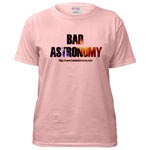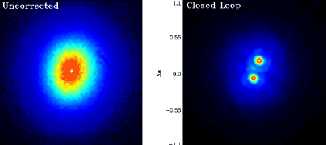
| Bad Astronomy |
|
|
|
BA Blog
|
|
Q & BA
|
|
Bulletin Board
|
| Media |
|
|
|
Bitesize Astronomy
|
|
Bad Astro Store
|
|
Mad Science
|
|
Fun Stuff
|
| Site Info |
|
|
|
Links
|
| RELATED SITES |
| - Universe Today |
| - APOD |
| - The Nine Planets |
| - Mystery Investigators |
| - Slacker Astronomy |
| - Skepticality |
Buy My Stuff

Keep Bad Astronomy close to your heart, and help make me
filthy rich. Hey, it's either this or one of those really
irritating PayPal donation buttons here.
Taking out the Twinkle
Week of August 30, 1999
Last week I talked about why stars twinkle. Briefly, it's because little packets of air bend the light from stars in random ways, making the image dance. It's very pretty, and many poems have been written about it.
Unfortunately, science is often not so poetic. While pretty, this twinkling (what astronomers call ``seeing'', an old and confusing term that has unfortunately stuck) plays havoc with astronomical observations. Since telescopes tend to take images that have long exposure times, the seeing smears out the object in the image. Seeing is measured by how much the light from a star is smeared out, and the usual unit is an arcsecond (one arcsecond is very small; it's 1/3600 of a degree). This is then a fundamental limit to how small an object we can see. Imagine two objects, one half the size of the other, but both smaller than the seeing. Because of seeing, they will both get blurred out to the same size, meaning we cannot tell which object is larger! Even worse, two objects that are close together get blurred together, and we cannot distinguish them. That really puts the brakes on how small an object we can detect.
Luckily, there are ways around seeing, but they cost. One solution is to get above the atmosphere. That's what Hubble does. It is not limited by atmospheric seeing, and so it can see objects with very high resolution. This is a nice solution, and it works very well indeed for space telescopes, but it's expensive.
Another method is to take very fast exposures of an object; in effect taking images faster than the seeing can blur the image. This only works with really bright objects, if you think about it. You can't see faint ones in such short exposures. Still, this method has been used to actually detect the size of the star Antares, a red giant that's so big it actually has a measurable (but very tiny) disk this way.
 A third, relatively new method, is to try to detect just how the seeing is
affecting the image, and actually warp the telescope mirror to
compensate. Amazingly, this method, called ``adaptive optics'', works
extremely well. It has been in use for a few years, and is now
used on the world's largest telescopes. It means that ground based
telescopes can have nearly as good resolution (that is,
the ability to see very small things) as Hubble. It's also cheaper
than launching a 'scope into orbit, and can be used on very large
mirrors (the image at left is from the
Canada France Hawaii Telescope,
and shows a before-and-after image of a double star; you can see how much
better the resolution is after the adaptive optics is switched on).
A third, relatively new method, is to try to detect just how the seeing is
affecting the image, and actually warp the telescope mirror to
compensate. Amazingly, this method, called ``adaptive optics'', works
extremely well. It has been in use for a few years, and is now
used on the world's largest telescopes. It means that ground based
telescopes can have nearly as good resolution (that is,
the ability to see very small things) as Hubble. It's also cheaper
than launching a 'scope into orbit, and can be used on very large
mirrors (the image at left is from the
Canada France Hawaii Telescope,
and shows a before-and-after image of a double star; you can see how much
better the resolution is after the adaptive optics is switched on).
 It's used by the VLT (which stands for ``Very Large Telescopes'',
believe it or not) in Chile run by the
European Southern Observatory
(Note: the ESO website is located in
Germany, and I have experienced very slow connections
there. I suggest patience when trying to connect there).
There are two methods for adaptive optics. One is that the main
mirror is set on a series of actuators, little rods with pistons that
press against the back of the mirror. A sensor figures out just
how much and in what direction the starlight is getting bent by
seeing, and the actuators distort the mirror shape to compensate.
The other method is to use a series of smaller, usually
hexagonal mirrors all fitted together, each with their own actuators.
The advantage of the second method is that it's easier to make
many small mirrors than one big one.
It's used by the VLT (which stands for ``Very Large Telescopes'',
believe it or not) in Chile run by the
European Southern Observatory
(Note: the ESO website is located in
Germany, and I have experienced very slow connections
there. I suggest patience when trying to connect there).
There are two methods for adaptive optics. One is that the main
mirror is set on a series of actuators, little rods with pistons that
press against the back of the mirror. A sensor figures out just
how much and in what direction the starlight is getting bent by
seeing, and the actuators distort the mirror shape to compensate.
The other method is to use a series of smaller, usually
hexagonal mirrors all fitted together, each with their own actuators.
The advantage of the second method is that it's easier to make
many small mirrors than one big one.
Either way, the control over the mirror is amazing. The distortions must be compensated on timescales of fractions of a second! Some amazing computer and engineering wizardry is needed for this.
But the results are astounding. By distorting the mirror in a known way, one of the VLT 'scopes was able to write its name on the sky! Those letters in the image are actually stars, wiggled around by the actuators in the VLT mirror. You can read more about how they made that image on their adaptive optics press release page.
It's not all fun and games. The images taken by the VLT array are astonishing and beautiful, some of the most dramatic and gorgeous astronomical images I have ever seen. Take a look for yourself! You can find them at their image index page. You can even order posters of some of the better images too. You can bet that at least one of these will be hanging in my house soon!
|
|
| THE PANTRY: ARCHIVE OF BITESIZE SNACKS |
|
|
| Subscribe to the Bad Astronomy Newsletter! |
| Talk about Bad Astronomy on the BA Bulletin Board! |